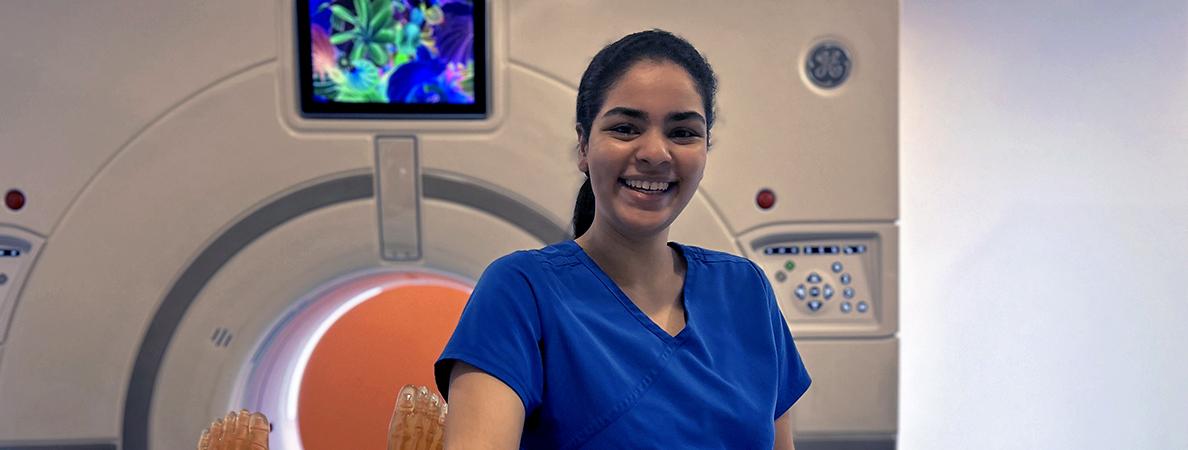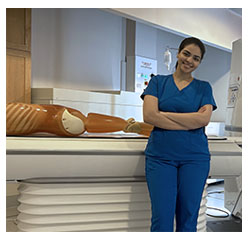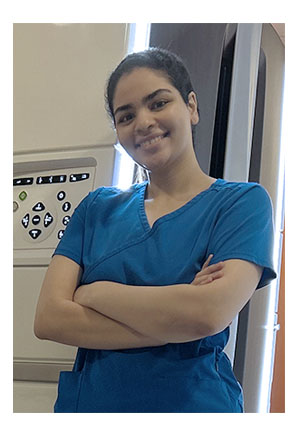
Habiba always knew she wanted to work in the medical field, but she wasn’t sure what role she wanted to play. What she did know was that her excellent high school grades put her in a strong position to enter a competitive program. She decided the Medical Radiation Sciences program at Mohawk College was the right fit for her because it offers a combination of a college diploma and a university degree. “I knew that I wanted to get into some kind of work in the medical field, and I wanted an easier and faster way to reach that goal than medical school,” said Habiba.
When Habiba realized that medical school wasn’t the right path for her, she considered going into nursing, before discovering another pathway into the medical field: the Medical Radiation Sciences program at Mohawk. “I think nursing is a very respected program to get into, and nurses are needed everywhere. However, I wanted something different, and that's why I looked into Medical Radiation Sciences program,” said Habiba. “I found that Mohawk College and McMaster University have a joint agreement where you can get a college diploma as well as a university bachelor's degree.”
 Habiba knew how competitive college and university programs can be, and she worked hard to build a strong educational foundation for her future while she was still in high school. “I joined the program right after high school. This program has grade requirements in subjects like chemistry, biology, English, and math, as well as a preference for students who have taken physics,” said Habiba. “I knew that in high school my plan was to take everything, just in case, which I highly recommend to anybody who wants to join this program.”
Habiba knew how competitive college and university programs can be, and she worked hard to build a strong educational foundation for her future while she was still in high school. “I joined the program right after high school. This program has grade requirements in subjects like chemistry, biology, English, and math, as well as a preference for students who have taken physics,” said Habiba. “I knew that in high school my plan was to take everything, just in case, which I highly recommend to anybody who wants to join this program.”
Students who join the Medical Radiation Sciences program choose one of three streams to specialize in during their studies: ultrasound, radiography, and radiation therapy. “We don't specialize right away in first year,” said Habiba. “It's a very general, very dense workload in first year because we're learning things that don't really relate to the program necessarily.
“In first year, the main goal is to slowly introduce students to all three streams,” she continued. “Every now and then we'll have meetings where they'll invite people over to talk about the different three streams, so that we can get an idea of what each stream has to offer and pick our preferences.” Habiba chose to specialize in radiography. “Your education becomes so much more specialized because you are specifically studying for that stream that you're in.”
Once students have selected their stream, the following semesters give them an opportunity to experience their stream while working in the field through two clinical placements. “When we dive into the hospital, we have a full-time schedule, and we're basically in the shoes of an actual technologist to learn how things flow in the hospital,” said Habiba. “It's very neat to have been exposed to the clinical experience early on in the program because it helped some people in my program decide whether the stream they chose is really the stream that want to continue in.”
 Habiba did her first placement at Hamilton General Hospital during the pandemic. “It was definitely an educational period, especially in a trauma hospital during that time,” said Habiba. “The Toronto hospitals were packed, so they would actually send patients off to our hospital. It was a crazy workload, but it taught me a lot.”
Habiba did her first placement at Hamilton General Hospital during the pandemic. “It was definitely an educational period, especially in a trauma hospital during that time,” said Habiba. “The Toronto hospitals were packed, so they would actually send patients off to our hospital. It was a crazy workload, but it taught me a lot.”
In her fourth year, Habiba secured a placement working with sick kids at the McMaster Children’s Hospital. “It was totally different - a different type of workload, different type of flow and so on,” said Habiba. “It was terrifying at the beginning because dealing with children is completely different than dealing with adults.”
While the experience was terrifying at first, Habiba is thankful for the confidence she has gained through working in the field. “I would say the proudest thing that I've done in this program would be actually confidently being able to provide optimal patient care and prioritizing patient care and making sure that the patient is doing well,” she said.
Habiba has never backed down from the hard work required from her program, and her dedication is coming to fruition in the form of a full-time job, before she has even graduated. “I’ve actually already secured a job working with Sick Kids when I graduate. A lot of my friends, including me, have gotten hired right after our placements. When you're leaving placement, you are ready to be hired at that point,” said Habiba. “It's a very dense program, however it definitely pays off.”
She advises students who are interested in the Medical Radiation Sciences program to work hard and not give up on their goals. “If you're coming from high school, definitely make sure you take all the courses, all the science courses, even physics. Make sure that you're keeping track of the required courses and make sure that you're keeping your grades up in those, because at the end of the day, you're building your future. If you set your mind to it, keep studying and keep your grades up, you’ll probably get into the program where you can enjoy four years of hard work and the rewards that come with it.”




